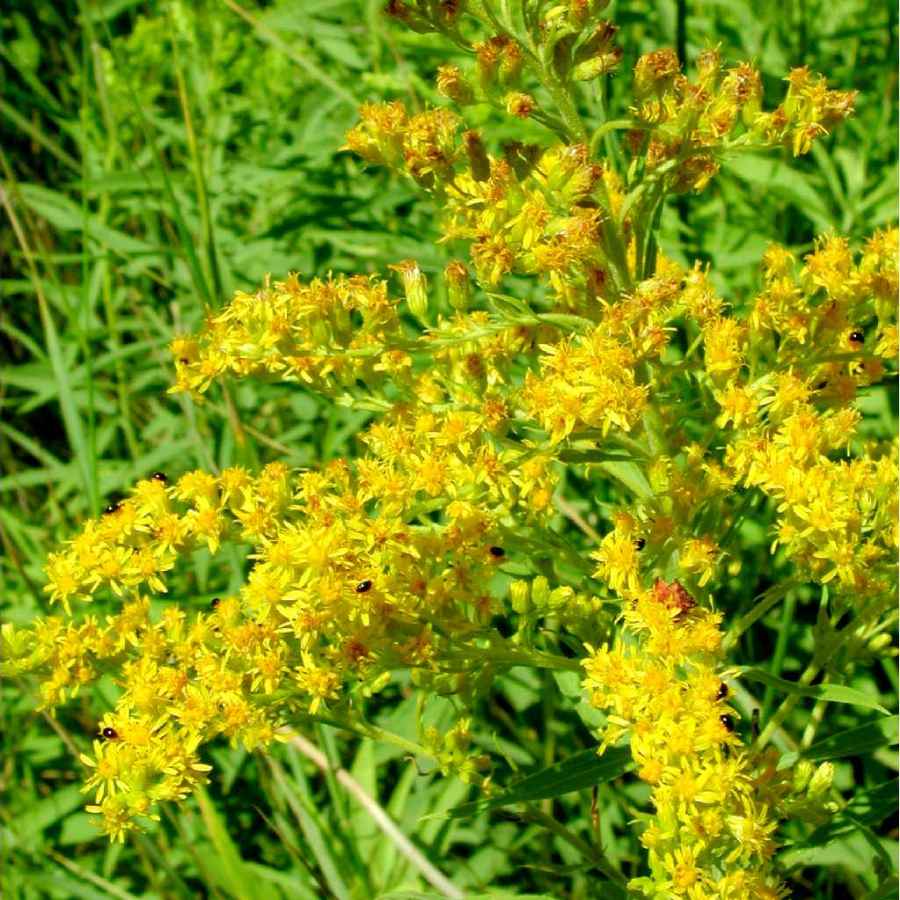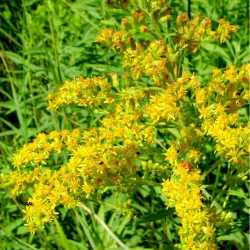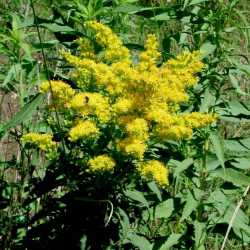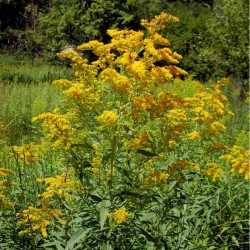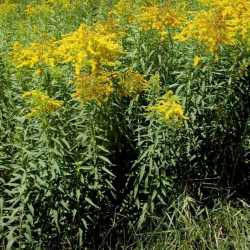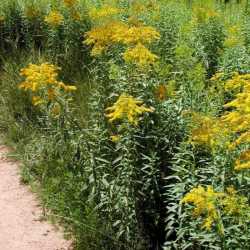Plants 50-200 cm; rhizomes short- to long-creeping. Stems 1-40+, usually short-hairy throughout, sometimes proximally glabrescent. Leaves: basal 0; proximal cauline usually withering by flowering; sessile or subpetiolate, tapering to bases; blades oblanceolate, 95-150 × 16-20 mm, relatively thick and firm, entire to serrate along distal 1 / 2 , strongly 3-nerved, apices acute to acuminate, abaxial faces finely strigose, more so along nerves, adaxial ± scabrous; mid to distal cauline blades oblanceolate (proximally) to lance-olate (distally), mid (30-)45-100(-170) × (5-)7-16(-25) mm, much reduced distally [(15-)25-55 × (3-)4.5-10(-17) mm], margins finely serrate (teeth 0-6(-14) per side on mid), distally usually becoming entire or remotely serrulate, adaxial faces ± scabrous, abaxial moderately strigillose, densely villoso-strigillose along nerves, distal sometimes minutely stipitate-glandular. Heads (15-)100-1200+, secund, in secund, pyramidal, paniculiform arrays, branches divergent and recurved, sometimes ascending-divergent, sometimes merely club-shaped thyrsiform in small plants, 5-30 × 2-25 cm (often 1.5-2 times as long as wide in southern plants). Peduncles 1-3.5 mm, moderately densely short hispiduloso-strigillose, sometimes minutely stipitate-glandular; bracteoles linear, sometimes minutely stipitate-glandular. Involucres narrowly campanulate, 2.5-4.5 mm. Phyllaries in ca. 3 series, strongly unequal; outer lanceolate, acute, inner linear-lanceolate, margins rarely minutely stipitate-glandular, apices acute to obtuse. Ray florets (5-)8-13(-17); laminae 0.7-1.5(-2) × 0.1-0.4(-0.5) mm. Disc florets (2-)3-6(-9); corollas usually 2.3-3.6 mm, lobes 0.5-0.9(-1.2) mm. Cypselae (narrowly obconic) 0.5-1.5 mm, sparsely to moderately strigillose; pappi 2.5-3.5 mm.
Solidago altissima has often been treated as S. canadensis var. scabra. The short hairs of the leaves can give fresh plants a gray-green tone not seen in S. canadensis var. canadensis. Numerous studies on S. altissima and its insect galls have been published by ecologists and entomologists (see W. G. Abrahamson and A. E. Weis 1997). Both subsp. altissima and subsp. gilvocanescens often have large insect galls (1-3 cm) on the mid to distal stems, unlike plants of S. canadensis and S. lepida. The species is divided here into two subspecies, at times difficult to distinguish: one eastern, one on the Great Plains.
Subspecies 2 (2 in the flora): c, e North America, Mexico; introduced worldwide.
Duration: Perennial
Nativity: Native
Lifeform: Forb/Herb
General: Perennial herbs, 50-200 cm tall, from creeping rhizomes; stems 1-40 or more per plant, short-hairy throughout, though sometimes nearly glabrous towards the base.
Leaves: Alternate and sessile to nearly sessile along the stems; blades oblanceolate to lanceolate, 9-15 cm long and 16-20 mm wide, relatively thick and firm, with 3 veins, more-or-less scabrous on upper surface and finely strigose on lower surface, more so on the veins; leaf margins entire, sometimes serrate above the middle.
Flowers: Flower heads obscurely radiate, yellow, numerous in showy terminal pyramid-shaped or club-shaped panicles 5-30 cm long or longer, the flower heads secund (on one side of the branches only) and the panicle branches divergent and recurved; flower heads subtended by linear, minutely stipitate-glandular bracteoles; involucres narrowly campanulate, 2-5 mm high, the bracts (phyllaries) strongly unequal in about 3 series, the outer phyllaries lanceolate with acute tips and the inner phyllaries a little narrower; ray florets 5-17 per flower head, the laminae (ray petals) about 1 mm long, yellow; disc florets 2-9 per flower head, yellow.
Fruits: Achenes about 1 mm long, narrowly obconic, and sparsely to moderately strigose; topped with a pappus of white bristles, 3 mm long.
Ecology: Found on roadsides, disturbed habitats, and open sites, from 2,500-8,500 ft (762-2591 m); flowers August-October.
Distribution: Throughout North America from the southern Canadian Provinces, south through the US, to Mexico.
Notes: There are 2 subspecies of S. altissima; var. altissima has involucres 3-4 mm high and is considered native to the eastern US but escaped from cultivation in many western states. Var. gilvocanescens has 2-3 mm involucres and is considered native to the Great Plains states, from NM and TX north to MT, ND, MN, and IL. Solidago altissima has been considered to be a variety of S. canadensis in the past, but FNA treats it as a distinct species; according to FNA, S. canadensis only occurs in the upper midwest and eastern US. Solidago altissima appears quite similar S. velutina; distinguish them by the stem pubescence (S. velutina has velvety stems while S. altissima has sparsely short-hairy stems) and the leaves (S. altissima tends to have leaves more densely crowded than S. velutina, and S. velutina can sometimes have narrower leaves than S. altissima.
Ethnobotany: Unknown, but other species in the genus have uses.
Etymology: Solidago from the Latin solidus, whole, and ago, resembling or becoming, alluding to the healing properties of some members of the genus; altissima means tall.
Synonyms: Solidago canadensis var. altissima, Solidago canadensis var. gilvocanescens
Editor: AHazelton 2017


